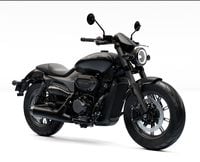More years back than I care to remember, I was taught how to check a motorcycle’s wheel alignment using a piece of kite string. Back in those days, few manufacturers thought it was necessary to cast datum marks into the swingarm and those that were there tended to be inaccurate, so every time the chain was adjusted you needed to check the wheel alignment. Things are much better these days, and in most cases simply paying careful attention to your rear wheel alignment marks is good enough. Nonetheless, good enough sometimes isn’t, if you catch my drift, and on occasion you’ll need to ensure that both wheels are really in line, if only for peace of mind. While you can use string, two straightedges, or a dedicated wheel-alignment tool, the easiest way to check the wheel alignment that I’ve come up with is by using two 8-foot fluorescent lamp tubes, available at most hardware stores for under $10. Here’s how to do it:
Position the bike vertically, with both wheels as close to in line as possible. (Use the center stand, a bike lift, jack or even a milk crate to support the bike.)
Place an 8-foot fluorescent tube along either side of the rear wheel just above the bottom of the rim, making sure that the tubes touch the wheel in two spots. Use two large rubber bands or small bungee cords to secure them.
- With the front wheel centered between the tubes, measure the gap at the front and rear of the tire. All four gaps should be equidistant. Of course, if both tires are the same size, the tubes should touch at all four spots.
If the gaps are different, use the rear-wheel adjusters to reposition the wheel slightly. Oh yeah, don’t forget that some shaft-driven bikes may have the rear wheel slightly offset.
Check out some other helpful tech tips here.










/cloudfront-us-east-1.images.arcpublishing.com/octane/SHXPGKYQEDEBE3X55MFAM3JRTA.jpg)
/cloudfront-us-east-1.images.arcpublishing.com/octane/O46AWNN23XOX5DLRXCFOLP4ZDM.jpg)
/cloudfront-us-east-1.images.arcpublishing.com/octane/OQVCJOABCFC5NBEF2KIGRCV3XA.jpg)
/cloudfront-us-east-1.images.arcpublishing.com/octane/F3O2DGLA4ZBDJGNVV6T2IUTWK4.jpg)
/cloudfront-us-east-1.images.arcpublishing.com/octane/ZXYQE3MHLFDSPKNGWL7ER5WJ4U.jpg)
/cloudfront-us-east-1.images.arcpublishing.com/octane/RDF24VM7WVCOBPIR3V3R4KS63U.jpg)
/cloudfront-us-east-1.images.arcpublishing.com/octane/W7RSIBFISNHJLIJESSWTEBTZRQ.jpg)
/cloudfront-us-east-1.images.arcpublishing.com/octane/AERA26ENRNBW3K324YWCPEXYKM.jpg)
/cloudfront-us-east-1.images.arcpublishing.com/octane/YWX3YX7QBBHFXFDMEEEKRG4XJE.jpg)
/cloudfront-us-east-1.images.arcpublishing.com/octane/I7OKI53SZNDOBD2QPXV5VW4AR4.jpg)
/cloudfront-us-east-1.images.arcpublishing.com/octane/IH52EK3ZYZEDRD3HI3QAYOQOQY.jpg)
/cloudfront-us-east-1.images.arcpublishing.com/octane/K2FSAN7OWNAXRJBY32DMVINA44.jpg)
/cloudfront-us-east-1.images.arcpublishing.com/octane/G4XK7JL24FCUTKLZWUFVXOSOGE.jpg)
/cloudfront-us-east-1.images.arcpublishing.com/octane/JJNXVAC27ZCDDCMTHTQZTHO55Y.jpg)










/cloudfront-us-east-1.images.arcpublishing.com/octane/3VSTLPKOHNFTRJTIAAXDPGCPA4.jpg)
